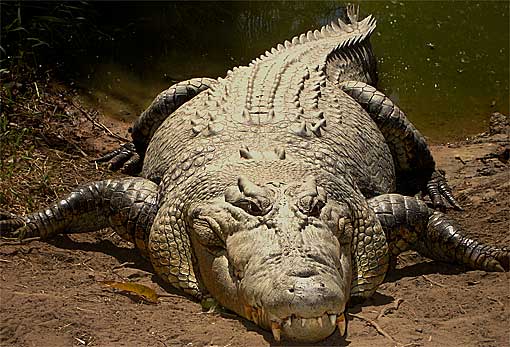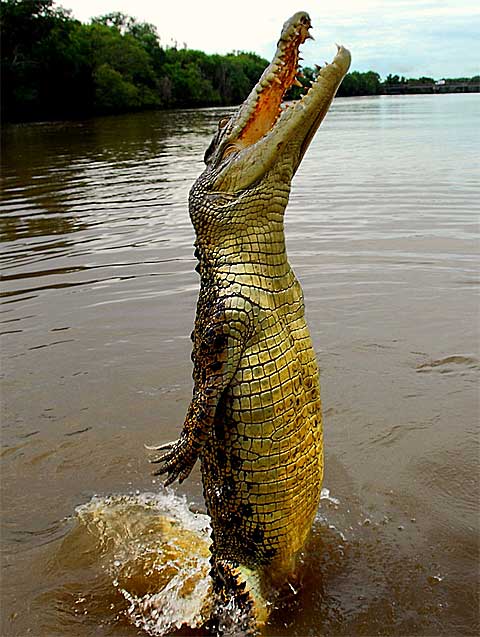Crocodiles – Ferocious Dinosaurs, Largest Reptiles

Saltwater Crocodile
Crocodiles spend much of their time basking under the sun or skimming the water. They may often appear slow and lazy, but they can strike and move with incredible speed. However, parents can set aside their ferocious behavior when its time to care for their young. In fact, crocodile parents are more attentive to their young than any other group of living reptiles.
The largest member of the croc family is the massive estuarine or saltwater crocodile under protection in India. They are also in parts of Southeast Asia and Australia. The larger specimens (males are much bigger) may be around 17 ft (5.2 m) long and several have measured 20 ft (6.1 m). The largest ever measured was 23 ft (7 m). The largest of all reptiles, some may weigh up to 2,900 lbs (1300 kg).
The tiniest in the croc family (the order Crocodylia which includes the Alligator family) is the dwarf caiman found on the northern tip of the South American continent. The females reach a maximum length of 4 ft (1.2 m), and the males seldom exceed 5 ft (1.5 M).

Jumping Croc
All crocodiles are carnivores, those teeth and jaws are not just for show. They feed on fish, turtles, water birds, gazelles, zebras, wildebeest etc, etc. To make eating meat easier, crocodiles are constantly growing new teeth. Even adults lose teeth to make room for new ones. Crocodiles have been known to swallow strange objects to aid in digestion. Stones, porcupine quills, metal, and pieces of turtle shells have been found inside crocodiles’ stomachs.
The Nile, or African crocodile has a long and broad body. Their stomachs are about the size of basketballs. They prefer fresh meat, but they often hunt a large animal and feed on it for a few days. The Nile crocodile is extremely dangerous and has been known to eat people. They are very quick and they slide down the muddy river banks, diving into the water to catch prey.
The saltwater crocodile lives in coastal marshes. Most crocodiles prefer fresh water, but they all can survive in saltwater. Obviously by their name, the saltwater croc is the only one that chooses to live out of fresh water. They often swim far out into the sea and are mistaken for sea creatures or monsters. They can also be very clever about riding underwater currents to take them long distances in the ocean – Crocs riding ocean currents.
Born with wrinkled faces, it is not easy to know exactly how old a croc is. Checking their teeth out seems to be the best method. On average they live to about 70 years old, some live to 100 and there is one in an Australian zoo estimated to be 130 years old.
